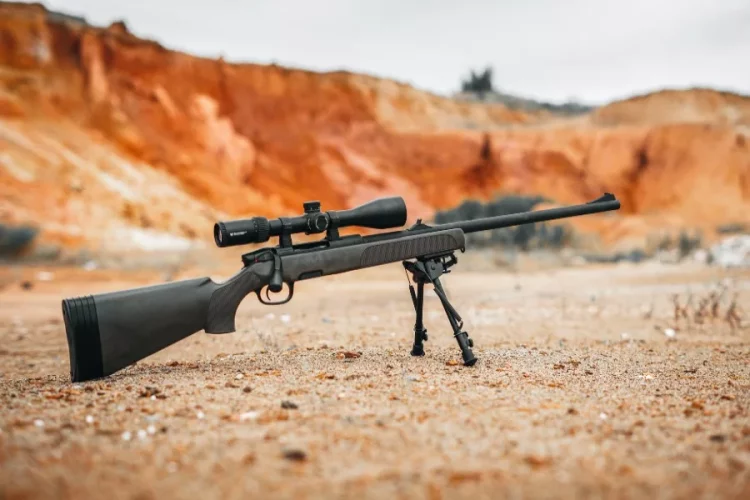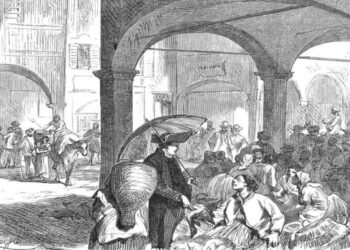Back in the day, a rifle became a game-changer invention. The term “rifle” is derived from the name of its unique feature that sets this piece of weaponry aside from the other firearms of old times.
What Defines Rifles?
Before rifles came to the scene, people used muskets. Because muskets used a large smooth bore and lead balls as projectiles, they lacked accuracy. The bore is the interior of the firearm barrel. Though the firing was encumbered by loading, these weapons were still preferred over bows because of their knock-down power.
In the 18th century, engineers realized that adding a spiral pattern into the bore would result in a more stable flight path of a bullet. This spiral pattern was called “rifling” and consisted of grooves and lands. A spinning motion increased the accuracy, and elongated bullets traveled through the air easier.
The new design helped to take advantage of enemies with less advanced weapons and increased bounty from hunting.
Over time, different types of rifles appeared. So before we move on to the parts of a rifle, let’s familiarize you with these types.
Types Of Rifles
There are five types of rifles that are currently in use:
- Lever-action
- Bolt-action
- Semi-automatic
- Pump-action
- Break-action
As you see, the action is what allows us to distinguish between different designs. But what is it within the context of firearms? The action is the portion of a rifle, or any other firearm, that contains moving parts involved in loading, firing, and ejecting the cartridge. So basically, the action does all the magic.
A lever-action rifle was one of the first designs. It was a popular firearm in the old west after the Civil War. This design uses a lever that inserts a cartridge into the chamber with two motions. The complicated construction of lever-action rifles adds weight and makes them hard to repair.
Bolt-action rifles are known for their stunning accuracy and reliability. Having the bolt as the only moving part of the rifle, they are easy to handle and less prone to malfunctions. The bolt is the handle that sticks out from the right side. To feed a cartridge, you need to make four movements on a standard bolt-action rifle, and two movements on straight-pull bolt action rifles.
A semi-automatic rifle is the invention of the late 19th century. It is capable of faster sequences since it automatically removes the spent cartridge and inserts a new one. Just put the action into the firing position before shooting the first cartridge, and here you go. Semi-automatic means that you fire only one cartridge with each trigger pull.
The pump action is more common in shotguns, but you can also see it in rifles. A pump-action rifle uses a slide mechanism located on the bottom of the barrel. A backward motion ejects a spent cartridge, and a forward motion inserts a new one.
Break-action rifles are often single-shot and use a hinge mechanism to break the barrel forward.
Bolt-action and semi-automatic rifles are the most popular today, so let’s break up what parts they comprise and what their functions are. As you read, take a look at the rifle parts diagrams.
Bolt-Action Rifle Parts
Bolt-action rifles are great weapons when accuracy is prioritized. The only drawback of such a design is that you need to remove your dominant hand from the trigger to reload a rifle after each shot. Remington Model 700 is one of the most popular bolt-action rifles in the U.S.
Stock
This is a part that you hold against your shoulder to achieve stability when firing a rifle. Stocks were originally made of wood, and they are still today. However, more and more people opt for polymer stocks due to their lower price and resistance to abuse. Some stocks feature compartments for storing small gear.
Butt
The butt is a rear part of the stock that contacts the shooter’s body. It transfers recoil to the shooter and can absorb a portion of it when made of specific materials like hard rubber.
Trigger Guard
The D-shaped metal part secures the trigger from negligent discharge. It also serves as a reference point for your trigger finger.
Trigger
It’s a curved metal part that you pull to cause firing.
Safety
On a bolt-action rifle, this switch is located behind the bolt handle. When in on-position, it blocks the trigger and prevents a rifle from firing even when it’s loaded and charged.
Bolt Handle / Bolt
The bolt handle aids in cycling the rifle. When you lift the handle, it unlocks the bolt from the chamber and allows it to be pulled back. As the bolt travels to the rear, it opens the chamber and ejects a spent cartridge. Then a new cartridge takes its place. To chamber it, you need to push the bolt forward. By lowering the handle, you lock the bolt in place, which prevents it from moving back and forth. As you lift the bolt handle, the firing pin inside the bolt moves a bit backward to prevent accidental discharge during the bolt cycling.
Firing pin
It’s a needle-shaped piece of metal that strikes the cartridge primer and causes the powder to explode.
Barrel
It’s a metal tube with a rifled bore through which a bullet travels.
Muzzle
The front end of the barrel.
Forestock
It’s a wooden or polymer portion below the barrel that you hold with your non-trigger hand.
Internal Magazine
It’s located next to the trigger under the ejection port through which spent cartridges are extracted. To load a rifle, you need to pull the bolt into the open position.
Semi-Automatic Rifle Parts
The most recognizable semi-auto rifles are AR-15 for civilians and M-16 for military use. AR-15 and M-16 share most of their parts, with few exceptions. However, the following part of the article is dedicated to defining and describing AR-15 parts and their functions to reach a larger audience and avoid misinformation.
The AR-15 rifle anatomy comprises two major parts: the upper receiver group and the lower receiver group. Look at the AR-15 diagram above with parts breakdown for better navigation.
Upper Receiver Group
Barrel
The barrel performs the same function as in any other firearm. But with a customizable AR platform, you can choose what barrel length will meet your needs best. A longer barrel means higher accuracy.
Gas Block / Gas Tube
The gas block is located on the barrel, and the gas tube attaches it to the upper receiver. These two components manage the gas pressure used for rifle operation. When you fire a rifle, the bolt carrier group moves into the buffer tube under the gas pressure. This allows for the extraction of a spent cartridge and the chambering of a new one. The gas that follows the bullet reaches the gas block, goes down the gas tube, and exits through the gas key in the bolt carrier.
Bolt-Carrier Group
This is the action of the AR-15. It contains a firing pin, bolt, cam pin, extractor, and gas key.
Charging Handle
It’s located on the top, below the rear sight. When you need to insert a cartridge into the empty chamber to prepare a rifle for the firing sequence, you pull back and release this handle. When you fire your AR-15, the charging handle stays in place.
Ejection Port Cover
It covers the ejection port and prevents dirt, dust, and debris from getting into the rifle. If you don’t open it manually before firing, it will pop up with the bolt cycling.
Lower Receiver Group
The lower receiver is considered the firearm itself and contains a serial number.
Trigger Group
The trigger and the hammer are the main parts of the trigger group. You can adjust your AR-15 to your needs by choosing a lighter or heavier trigger. A lighter trigger ensures better accuracy and a faster firing sequence, but it also may lead to accidental discharges.
Buffer Tube / Buffer
Together with the spring, the buffer is a component of the buffer tube. The role of the buffer tube is to absorb recoil and slow down faster parts of the AR-15.
Magazine
On the AR-15, the magazine attaches to the part behind the trigger guard.
As you see from the diagrams, many stationary and a few moving parts of bolt-action and semi-automatic rifles are the same. We avoided duplicating them in the last part, so be sure to take a look at both rifle types for a better understanding.







